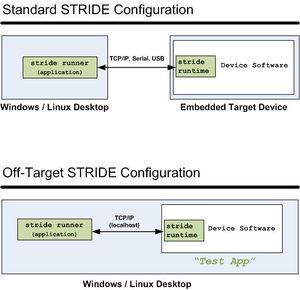Installation Overview
Introduction
The STRIDE test system consists of two major sub-systems:
To begin using STRIDE there are a number of installation steps required which will be outlined in this article.
The STRIDE Test Framework has three main components:
- Runner - host-based command-line utility for interactive and automated test execution
- Runtime - software source package that integrates with your embedded application software
- Build Tools - command-line utilities that integrate with your target software build process
STRIDE Test Space does NOT require installation, only an account setup (i.e. user-name and password).
Test Framework
The Test Framework enables the creation of fully automated Test Assets used to verify the internal design of your software. This section provides information on the required installation steps to enable executing STRIDE based tests.
User's Desktop
For the user there is a desktop installation package that contains the Runner and a number of associated artifacts. The package is a zip file and is targeted for either the Windows operating system or Linux.
When writing test cases both C/C++ and Perl can be used. As part of the installation a STRIDE specific Perl library is installed. If you intend on writing Perl base test scripts there are additional Perl module dependencies that required installation. Also, it is very important to validate the Perl specific installation.
Please refer to the following desktop installation instructions.
Off-Target (optional)
Two of the largest barriers to embedded developer productivity are long build/test cycles and scarce target hardware. Fortunately, STRIDE's cross-platform capabilities make it possible to run STRIDE in a host-only Off-Target Configuration that emulates your target system.
In order to conduct training or build and execute our Samples, we leverage this environment (i.e. single Windows or Linux (x86) computer for both the target and host systems). Host and target code will run in separate processes and communicate via TCP/IP, thus simulating an embedded target with host computer configuration. All code and techniques used in the Off-Target Environment are directly transferable to a production environment. This enables the user to create their own sandbox for training and Off-Target unit testing.
The Off-Target Environment utilizes the Framework's "SDK" that can be built and executed on the host system. When using the SDK Makefile a simulated target native application is generated, which we call a Test Application (TestApp).
The STRIDE Runner application executes on the same system and communicates with the TestApp process over a TCP/IP connection. This setup frees you from external hardware dependencies and provides for a rapid "edit/build/test" cycle.
Please verify that your Host system contains one of the following compilers:
- For Windows Microsoft Visual Studio 2005 or later is required. If you don't already have Visual Studio, the free Visual C++ Express can be used (download here).
- For Linux the GNU Compiler Collection (included by default in almost all Linux distros) is required.
For instructions on building a TestApp refer to the following article.
Target Integration
The Runtime and Build Tools are installed with your software application and development tool-chain as a one-time integration activity as described here. Typical developers are not required to understand the details involved with target integration.
Test Space
Test Space is used for storing and analyzing test results, thus providing on-demand availability of timely, accurate, and meaningful test results data.
To begin leveraging Test Space you are required to be assigned a URL with the following form:
https://yourcompanyname.stridetestspace.com
Once this has been assigned your administrator will setup accounts.
Please refer to the following Test Space Setup instructions.
